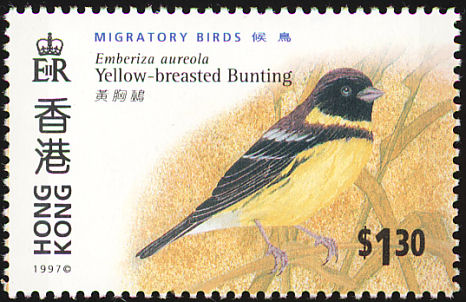In the mid-1990s, the observed decline of the Yellow-breasted Bunting Emberiza aureola in Hokkaido, Japan alerted conservationists that another super-abundant species might be in trouble. Now we know it has suffered a huge decline, possibly as much as 95 percent of its population, in the span of just two to three decades. Prior to 2004 the Yellow-breasted Bunting was not regarded as of conservation concern, but since 2013 it has been listed as Endangered, and this year the discussion on BirdLife’s Globally Threatened Birds Forum concerned a potential further uplisting to Critically Endangered.
In order to address and confront this little-known crisis, BirdLife International co-organised an international workshop on conservation of the Yellow-breasted Bunting with the Hong Kong Bird Watching Society (BirdLife in China (Hong Kong)) and the Sun Yat-sen University in Guangzhou, China in November 2016. The purpose of the workshop was to collect information and opinion for drafting an International Conservation Action Plan on the Yellow-breasted Bunting, and to form an international conservation network on this and other migratory passerines.
More than 50 experts from almost all major range countries attended the workshop. The main recommendations from the workshop were that the Yellow-breasted Bunting should be officially protected in all range countries, that its migration patterns should be managed using colour banding and geolocators, and that its breeding, migration and wintering sites need to be identified, surveyed, protected, and managed. It is also imperative to study the effect of agrochemicals on migratory passerines that use farmlands, and promote wildlife-friendly farming practices. International cooperation on the research and conservation of this species and other migratory passerines is necessary if we are to stabilise the numbers of Asia’s vanishing migrants.
The International Conservation Action Plan of the Yellow-breasted Bunting is expected to be published by 2019, as good consultation with different countries and stakeholders, including some regional and national workshops, are needed. However, important actions are already underway. In the breeding season of 2016, BirdLife International and Birds Russia conducted a preliminary study on the Yellow-breasted Bunting in Sakhalin, Russia. The result was alarming: it has seemingly disappeared completely from southern Sakhalin, and could only found at a few localities in northern and central parts of the island.
Source: Birdlife, October 2017
https://www.birdlife.org/worldwide/news/yellow-breasted-bunting-next-pa…

- Login om te reageren
